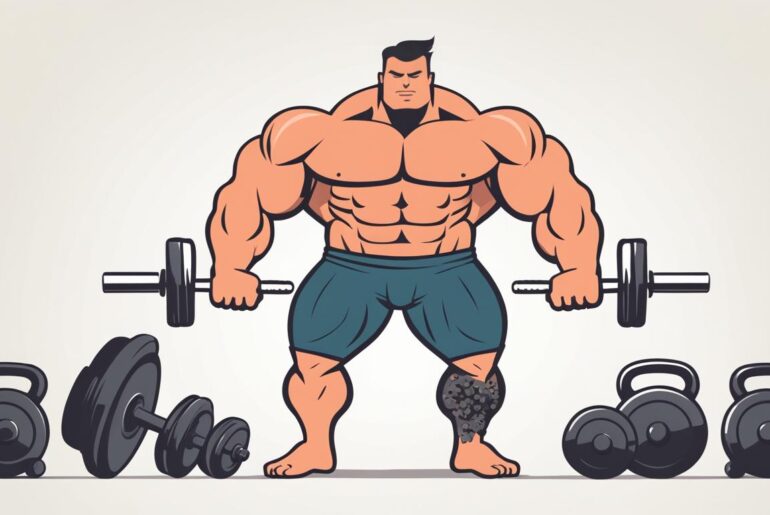Welcome to my article on keto workouts for rapid weight loss! If you’re looking to shed those extra pounds quickly and effectively, incorporating exercise into your ketogenic diet can be a game-changer. By combining the power of a low-carb, high-fat diet with targeted workouts, you can accelerate weight loss and achieve your goals in no time.
So, what makes keto workouts so effective? Well, exercise impacts ketosis by depleting glycogen stores in your body, which then leads to the metabolism of fat. The longer and more intense your workouts, the greater the impact on glycogen depletion, and ultimately, fat burning. Additionally, exercise helps to preserve lean muscle mass, which boosts your resting metabolic rate and aids in even more calorie burn, even when you’re at rest.
When it comes to choosing the right exercises for rapid weight loss on a ketogenic diet, there are a few key options to consider. Low-intensity steady-state cardio, such as walking, jogging, or cycling, is often more tolerable for those on keto. It helps burn fat without compromising your energy levels.
Strength training is another fantastic option for building muscle and increasing metabolism. Resistance exercises like weightlifting, squats, and push-ups can help you retain and grow lean muscle mass, which is crucial for long-term weight loss success.
But what about fueling your workouts on keto? While the diet primarily emphasizes low-carb consumption, you might find it beneficial to consume some carbohydrates before and after your exercise sessions. This provides the necessary energy for high-intensity workouts and supports your performance.
To further maximize your weight loss on keto, consider incorporating intermittent fasting into your routine and making sure you’re getting enough quality sleep. These additional strategies can enhance your results and keep you on track towards your weight loss goals.
Stay tuned for the rest of this article, where I’ll delve deeper into the effects of exercise on ketosis and weight loss, the best exercises to do while in ketosis, and other useful tips for optimizing your keto workouts. The road to a healthier, fitter you starts here!
Does Exercise Affect Ketosis?
Exercise plays a significant role in the process of entering and maintaining ketosis. By depleting glycogen stores, exercise triggers the metabolism of fat for fuel, effectively speeding up the transition into ketosis.
Longer and more intense physical activities have a greater impact on glycogen depletion compared to mild exercise. Interestingly, even shorter-duration activities like repeated sprinting and endurance training have been shown to lower glycogen stores.
“Exercise depletes glycogen stores, which triggers the metabolism of fat for fuel.”
However, it’s important to note that exercise can potentially affect performance on a ketogenic diet. In the absence of carbohydrates, which serve as the primary source of energy during high-intensity workouts, exercise performance may be negatively impacted.
Glycogen Depletion and Ketosis
Glycogen is the stored form of carbohydrates in the body, primarily found in the liver and muscles. During exercise, glycogen is broken down to provide quick energy. As glycogen stores become depleted, the body starts metabolizing fat for fuel, a key process in achieving and maintaining ketosis.
While longer and more intense physical activities deplete glycogen more quickly, it’s essential to find a balance that works for your body and fitness level. Understanding the impact of different types of exercise on glycogen depletion can help you make informed decisions about your workout routine while following a ketogenic diet.
Exercise Performance on a Ketogenic Diet
When starting a ketogenic diet, it’s common for individuals to experience a decrease in overall exercise performance initially. This is attributed to the body transitioning from using carbohydrates as its primary fuel source to using fat. High-intensity workouts rely heavily on glycogen, which may not be readily available in the absence of sufficient carbs.
However, as the body becomes more accustomed to burning fat for fuel, many individuals report an improvement in exercise efficiency, particularly for activities that rely on fat oxidation, such as low to moderate intensity endurance exercises.
It’s important to remember that the impact of exercise on ketosis may vary from person to person. Some individuals may thrive on high-intensity workouts even on a ketogenic diet, while others may find that their performance is affected.
As with any dietary or exercise program, it’s crucial to listen to your body and make adjustments based on your individual needs and goals. Consulting with a qualified healthcare professional or dietitian can provide personalized guidance for optimizing exercise performance while following a ketogenic diet.
Does Exercise Speed Up Weight Loss in Ketosis?
Exercising while in ketosis can greatly accelerate weight loss and optimize the benefits of a low-carb diet. When combined with a ketogenic eating plan, regular exercise can take weight loss to the next level and help you achieve your goals more efficiently.
The key to understanding the impact of exercise on weight loss in ketosis lies in the depletion of glycogen stores during physical activity. As you exercise, your body uses up its glycogen reserves, which are primarily derived from carbohydrates. With limited carbohydrate intake on a ketogenic diet, the body quickly turns to stored fat as a fuel source, leading to increased fat burning and more efficient weight loss.
Exercising in ketosis not only accelerates weight loss but also helps preserve lean muscle mass. This is crucial for maintaining a higher resting metabolic rate, which means you burn more calories even at rest.
Resistance training, such as weightlifting, is particularly effective for preserving and increasing muscle mass while in ketosis. By incorporating resistance exercises into your workout routine, you can help prevent muscle loss and promote the development of lean muscle. This not only contributes to your overall weight loss efforts but also helps sculpt and define your physique.
The Importance of Resistance Training on Keto
Resistance training on a ketogenic diet offers several unique benefits. First and foremost, it helps maintain and build lean muscle mass. This is beneficial for both weight loss and overall health, as muscle tissue burns more calories than fat tissue, even at rest. By engaging in regular resistance training, you can boost your metabolism and enhance the efficiency of your weight loss journey.
In addition to its impact on metabolism, resistance training also improves bone density, enhances posture, and increases overall strength and endurance. It is an essential component of a well-rounded fitness routine, especially when following a ketogenic diet.
Preserving Lean Muscle Mass in Ketosis
When you engage in a ketogenic diet with exercise, it’s important to prioritize preserving lean muscle mass. This can be achieved by consuming adequate protein, staying properly hydrated, and following a well-designed workout plan that includes resistance training.
By including resistance exercises, such as weightlifting or bodyweight exercises, in your fitness routine, you can help counteract the muscle loss that can occur during weight loss. Focus on compound exercises that target multiple muscle groups and vary your workouts to challenge your body and promote muscle development.

What Types of Exercises Should I Do While in Ketosis?
When it comes to exercising while in ketosis, the key is to find activities that align with your preferences and fitness level. There are several types of exercises that can be beneficial for individuals following a ketogenic diet. Let’s explore the best options for maximizing your workout routine while in ketosis.
The Importance of Low-Intensity Steady-State Cardio
For beginners, low-intensity steady-state (LISS) cardio exercises are often more tolerable on a keto diet. These exercises, such as walking, running, cycling, or swimming, provide a moderate challenge without putting excessive stress on the body. LISS cardio has been shown to effectively reduce total body fat and improve fat distribution, making it an excellent choice for those looking to shed extra pounds.
Strength Training to Build Muscle and Improve Metabolism
Strength training exercises are another great option for individuals in ketosis. Weightlifting, squats, pushups, and other strength training activities help build and maintain muscle mass, which is essential for a healthy metabolism. By increasing your muscle mass, you’ll experience a higher resting metabolic rate, meaning you’ll burn more calories even at rest. Incorporating strength training into your keto routine can help you achieve a toned and sculpted physique.
High-Intensity Workouts for a Challenge
If you’re looking for a more intense workout, you can also incorporate high-intensity exercises into your routine while in ketosis. However, it’s important to note that high-intensity workouts like burpees and sprints may require you to reach a fat-adapted state by consistently following the keto diet. These exercises push your body to its limits, resulting in increased calorie burn and improved cardiovascular fitness. Just be sure to listen to your body and adjust the intensity as needed to avoid overexertion.
Remember, the best exercises for ketosis will vary depending on your personal preferences and fitness goals. It’s essential to choose activities that you enjoy and that align with your abilities. By finding the right balance between low-intensity steady-state cardio, strength training, and high-intensity workouts, you can optimize your workout routine and maximize the benefits of being in ketosis.
| Exercise Type | Benefits |
|---|---|
| Low-Intensity Steady-State Cardio (LISS) | – Effective for reducing total body fat – Improves fat distribution – More tolerable for beginners |
| Strength Training | – Builds and maintains muscle mass – Increases resting metabolic rate – Tones and sculpts the body |
| High-Intensity Workouts | – Provides a challenge for advanced individuals – Increases calorie burn – Improves cardiovascular fitness |
Should I Eat Carbs If I Exercise While on Ketosis?
While following a keto diet involves limiting carb intake, incorporating some carbohydrates before and after exercise can be advantageous in fueling your workouts. Consuming carbs in strategic portions can provide the necessary energy for high-intensity exercises on a ketogenic diet.
For example, eating around 25 grams of carbs 30-60 minutes before a workout can supply your body with immediate energy to enhance performance. Additionally, consuming another 25 grams of carbs as part of your post-workout recovery can replenish glycogen stores and support muscle repair.
It’s important to note that the standard carb limit for a keto diet is typically up to 50 grams per day. However, individuals with high activity levels, such as athletes or those engaged in demanding workouts, may be able to consume slightly more carbs while still maintaining ketosis.
Monitoring your ketone levels can help you determine if you’re still in ketosis despite consuming these additional carbs. This can be done using urine, blood, or breath ketone testing methods. Adjusting your carb intake based on your body’s response and your specific goals is key to finding the optimal balance between fueling your workouts and maintaining ketosis.
| Benefits of Eating Carbs for Exercise on Keto | Tips for Carb Consumption During Exercise on Keto |
|---|---|
|
|
Remember, individual responses to carb consumption may vary, so it’s essential to experiment and find the approach that works best for you. Consulting with a healthcare professional or registered dietitian who specializes in ketogenic diets can provide personalized guidance based on your specific needs and goals.

Other Tips to Speed Up Weight Loss in Ketosis
In addition to exercise, there are other strategies that can further enhance your weight loss journey on a ketogenic diet. Incorporating these tips into your routine can help you achieve your goals more efficiently and effectively.
Intermittent Fasting on Keto
Intermittent fasting is a popular eating pattern that involves cycling between periods of eating and fasting. This practice can be particularly beneficial when combined with a ketogenic diet. By restricting your eating window and extending the period of time between meals, you can optimize fat burning and promote weight loss. Consider incorporating intermittent fasting into your keto routine to supercharge your results.
Reducing Snacking on Keto
Snacking between meals can contribute to overeating and hinder your weight loss progress on the keto diet. Instead of reaching for unnecessary snacks, focus on consuming balanced and satisfying meals that keep you feeling full for longer. By reducing snacking and focusing on nutritious, whole foods, you can maintain a calorie deficit and accelerate your weight loss journey.
Improving Sleep for Weight Loss
Sleep plays a crucial role in weight management. Lack of quality sleep can disrupt hormone levels, increase appetite, and negatively affect your mood and motivation for exercise. Aim for at least 7 hours of quality sleep each night to support weight loss efforts. In addition, establishing a consistent sleep schedule and creating a relaxing bedtime routine can help improve sleep quality.
Zero-Carb Snacks on Keto
When hunger strikes between meals, having zero-carb snacks on hand can be a game-changer. These snacks provide a satisfying crunch without derailing your ketosis. Consider incorporating zero-carb snacks such as boiled eggs, beef jerky, and canned tuna into your keto diet for a quick and convenient way to curb hunger and stay on track.

By following these tips, you can optimize your weight loss journey on the ketogenic diet. Intermittent fasting, reducing snacking, improving sleep, and choosing zero-carb snacks will support your efforts and help you achieve your goals faster. Remember to stay consistent, listen to your body, and consult with a healthcare professional before making any significant changes to your diet or exercise routine.
How to Have the Best Workouts on a Low-Carb & Keto Diet
When starting a low-carb or keto diet, it’s important to allow your body time to adjust to the new fuel source. During the adaptation phase, it’s recommended to focus on low-intensity workouts and gradually increase intensity as your body becomes accustomed to burning fats instead of carbohydrates.
Adjusting workouts on a low-carb keto diet requires patience and a listening ear to your body’s signals. At first, you may experience a decrease in performance as your body adapts to the changes. It’s important not to get discouraged during this transition period.
It may help to supplement your low-intensity workouts with other forms of exercise that are better suited for a keto diet. High-intensity workouts, such as HIIT (high-intensity interval training) or heavy weightlifting, can put strain on your body’s glycogen stores, which are already depleted on a low-carb diet.
Instead, consider incorporating low-impact exercises like walking, swimming, or yoga into your routine. These activities can still provide a good workout while being gentle on your body and ensuring that you stay within your carbohydrate limits.
As you become more fat-adapted and your energy levels stabilize, you can gradually increase the intensity of your workouts. Pay attention to how your body responds and adjust your carbohydrate intake accordingly to maintain a state of ketosis.
Remember that everyone’s journey on a low-carb or keto diet is unique. Find what works best for you and adapt your workouts accordingly. Listening to your body and making adjustments as needed will ensure that you have the best workouts on a low-carb and keto diet.

By adjusting your workouts to complement your low-carb or keto diet, you can optimize your fitness routine while still reaping the benefits of a low-carb lifestyle. With time and consistency, you’ll find a balance that works for you and helps you achieve your health and fitness goals.
Conclusion
Incorporating exercise into a ketogenic diet can greatly enhance weight loss and promote the preservation of lean muscle mass. Two effective forms of exercise on a ketogenic diet are low-intensity steady-state cardio and strength training. Low-intensity steady-state cardio, such as walking or cycling, can help burn fat and improve overall cardiovascular health. Strength training exercises, such as weightlifting, are crucial for building and maintaining muscle mass on a low-carb or keto diet.
Consuming carbohydrates strategically around exercise sessions can also be beneficial for performance. Eating a small amount of carbs, such as 25 grams, before and after workouts can provide the necessary energy to power through intense training sessions. On top of exercise, other strategies to maximize weight loss on keto include intermittent fasting, reducing snacking, and prioritizing quality sleep. Intermittent fasting can help accelerate fat burning, while reducing snacking can prevent unnecessary calorie intake.
It is important to always listen to your body and make adjustments to your workouts as needed. Every individual is unique, and what works for one person may not work for another. Working with a professional, such as a registered dietitian or personal trainer, can help tailor your exercise and nutrition plan to optimize your results on a low-carb or keto diet. Remember, consistency is key, and with the right approach, you can achieve your weight loss goals while maintaining a healthy lifestyle.
FAQ
Do exercise speed up ketosis?
Exercise can help expedite the process of entering ketosis. It works by depleting glycogen stores, which triggers the metabolism of fat for fuel.
Does exercise speed up weight loss in ketosis?
Exercising while in ketosis can accelerate weight loss. The depletion of glycogen stores during exercise, combined with a low-carb diet, can take weight loss to the next level.
What types of exercises should I do while in ketosis?
The types of exercises you should do while in ketosis depend on your preferences and fitness level. Most beginners find low-intensity steady-state (LISS) cardio, such as walking, running, cycling, or swimming, to be more tolerable. Strength training exercises like weightlifting, squats, and pushups are also ideal for building muscle and improving metabolism.
Should I eat carbs if I exercise while on ketosis?
While the keto diet limits carbs, consuming some carbohydrates before and after exercise can be beneficial. For example, eating 25 grams of carbs 30-60 minutes before a workout and another 25 grams as part of the post-workout recovery can provide the necessary energy for high-intensity workouts.
What are other tips to speed up weight loss in ketosis?
In addition to exercise, other strategies to maximize weight loss on keto include intermittent fasting and minimizing snacking between meals. Getting enough sleep is also essential for weight management, as lack of sleep can increase appetite and cravings.
How to have the best workouts on a low-carb & keto diet?
When starting a low-carb or keto diet, it’s important to allow your body time to adjust to the new fuel source. During the adaptation phase, it’s recommended to focus on low-intensity workouts and gradually increase intensity as your body becomes accustomed to burning fats instead of carbohydrates.
Conclusion
Incorporating exercise into a ketogenic diet can enhance weight loss and preserve lean muscle mass. It’s important to listen to your body, adjust workouts as needed, and work with a professional to maximize your results on a low-carb or keto diet.




